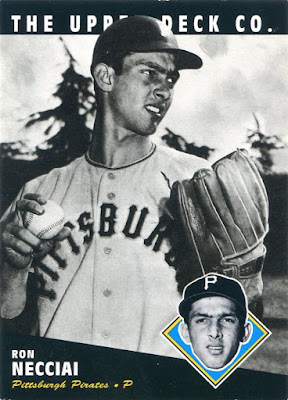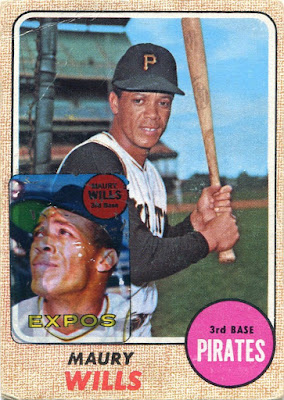It's hard to say what my feelings are towards the Pirates.
I can't say I actively root for them, since it's hard to root for any team that plays in the same division as the Cubs. But at the same time, the sympathetic baseball fan in me can't help but want to see a cellar-dwelling team like the Bucs finally pull through and make a run at a title.
Until their magical 94-68 finish in 2013, the Pirates hadn't had a winning season since 1992 -- the year I was born. They perennially sat at or near the basement of the NL Central before becoming the pennant-contender they've transformed into in recent years (save for 2016).
I may have my conflicts towards the Pirates as a franchise, but there's little disputing the fact that they've accumulated a prodigious Short Term Stops roster.
Pitchers
1994 UD All-Time Heroes #203 Ron Necciai
"Short Term Stops" Pirates Accolades:
Ron Necciai (1952 Pirates, 12 games, sunset season)
We begin with a bit of an oddball-ish member of the squad.
Ron Necciai isn't a name most casual fans know. He did, after all, only spend a single season in the big leagues (1952), posting a mediocre 1-6 record to go along with a 7.08 ERA.
But the man behind the numbers is quite a story. Necciai was a highly-touted prospect in his heyday, and on May 13, 1952, he did the unthinkable as a member of the Bucs' minor league affiliate in Bristol: he struck out 27 batters...in a nine-inning game.
With a feat like that, it's sad that the baseball world didn't get to see more of Ron Necciai.
1978 Kellogg's #8 Goose Gossage
Goose Gossage (1977 Pirates, 72 games)
Here's one of my all-time favorite Short Term Stops.
Goose Gossage posted stellar numbers during his lone season as a Pirate. His 1.62 ERA and 26 saves were good enough to earn him an All-Star berth in '77 and a fat contract from the Yankees the following offseason.
For a long time, however, I thought no Pirates cards existed of Goose. He's still a member of the White Sox on
his '77 Topps issue, and he was (heavily) airbrushed into Yankee pinstripes for
'78 Topps. But unbeknownst to me, both
Hostess and Kellogg's documented Gossage's brief Pirates career.
The Kellogg's card is particularly awesome, and might just be my favorite card in the history of the hallowed 3-D brand.
1982 Topps #160 Luis Tiant
Luis Tiant (1981 Pirates, 9 games)
El Tiante was on his last legs by the time he became a Pirate.
He spent a single injury-riddled season in Pittsburgh, going 2-5 with a 3.92 ERA in just nine games with the '81 Bucs. He'd pitch in six games for the Angels the following year before calling it a career.
This, as far as I know, is Tiant's only card as a Pirate, and it's good to see the injuries didn't kill the Fu Manchu and that effervescent smile.
Catcher
2005 Donruss Team Heroes #149 Benito Santiago
Benito Santiago (2005 Pirates, 6 games, sunset season)
Benito Santiago seems so quintessentially '90s that it's almost hard to believe his career lasted until 2005.
The Pirates were the ninth and final team Benny would suit up for during his 20 years as a big-league backstop, though the stint was far from memorable. Santiago appeared in just six games for the 2005 Bucs, hitting .261 in 23 at-bats before being released in May.
At least it resulted in one of the few notable cards I've ever seen from Donruss Team Heroes.
First Base
2002 Topps American Pie #94 Hank Greenberg
Hank Greenberg (1947 Pirates, 125 games, sunset season)
I don't know what my all-time favorite Short Term Stop is, but Hank Greenberg as a Pirate would definitely be in the running.
The backstory of how Greenberg wound up in Pittsburgh is fascinating enough. The Tigers sold Hank to the Pirates after a misunderstanding stemming from a wartime photo depicting Greenberg in Yankee pinstripes, which he'd only worn because he'd forgotten his Tigers jersey and no other uniforms were available that day.
Greenberg wanted to retire as a career Tiger, but the Pirates coaxed him out of it. He'd spend one final season in the bigs, posting a .274-25-74 line in 125 games for the '47 Bucs before calling it quits for good.
Though it technically lists him as a Tiger, this American Pie card is the only one I've ever seen to feature Hank as a Pirate, which makes it one of the centerpieces of my collection.
Second Base
1976 SSPC #584 Willie Randolph
Willie Randolph (1975 Pirates, 30 games)
This card was a white whale of mine for a long time.
It's the only non-multi-player card I know of to feature Willie Randolph as a Pirate. Randolph, a largely unknown rookie at the time, spent just 30 games with Pittsburgh in '75, collecting the first ten of his 2,210 career hits in the process.
He'd be traded to the Yankees the following offseason and would go on to become a key cog in the Bronx Bomber dynasty teams of the late '70s.
Bet the Pirates wish they had that one back.
Shortstop
1998 Fleer Tradition #218 Shawon Dunston
Shawon Dunston (1997 Pirates, 18 games, half-year stint)
Like a few of the cards I've already mentioned, this is the only card I've ever seen of Shawon Dunston as a Pirate.
If you blinked, you might've missed Dunston's brief 18-game stint with the Bucs near the end of the '97 season. After being traded from the Cubs, Dunston hit a sparkling .394 during his short time in Pittsburgh, though it wasn't enough to boost the hopeful Pirates over the hump in the NL Central that year.
As a Cubs fan, it's a little weird seeing Dunston in anything other than blue pinstripes, but the Short Term Stop lover in me can't help but adore it.
Third Base
1968 Topps #175 Maury Wills
Maury Wills (1967-68 Pirates, 302 games)
It's not so much the brevity that earned Maury Wills a spot on this roster -- he did play in over 300 games with the Pirates, after all -- it's the unfamiliarity.
Wills is so ingrained in the minds of most baseball fans as a Dodger that he looks just plain wrong in anything else, despite the fact that he stole 81 of his 586 career bases during his two years as a Pirate.
This is the only Pirate card I own of Wills, and the fact that some young collector stuck Wills's '69 Topps Decal on the front for good measure gives it a cool kind of ghostly effect.
Outfielders
1990 Score #592 Moises Alou
Moises Alou (1990 Pirates, 2 games, half-year stint)
I remember being obsessed about this card when I was just getting interested in Short Term Stops as a young baseball fan.
It seemed incredible that a guy could play in two games with someone and yet
still have a card depicting him with that team, but that's exactly what happened with Moises Alou. His two games with the Bucs are documented on a handful of different cards, my personal favorite being his hallowed '90 Score rookie.
Alou collected exactly one hit in two at-bats as a Pirate before a late-season deal sent him to Montreal, beginning an auspicious career that would last until 2008.
It's cards like this one that laid the groundwork for my current Short Term Stops obsession.
1992 Stadium Club #784 Kirk Gibson
Kirk Gibson (1992 Pirates, 16 games)
Though he was just four years removed from his magical 1988 NL MVP campaign, Kirk Gibson's baseball career looked to be over by the time 1992 came around.
After having been traded to Pittsburgh the preceding offseason, Gibson would play in just 16 games with the '92 Pirates, hitting .196 with two homers before being released in May. The stint was so disheartening that it caused Gibson to announce his retirement. The lovable Sparky Anderson, however, convinced Gibson to sign with the Tigers for the '93 season.
Gibby would enjoy three more solid years with the Tigers -- his original team -- before hanging them up for good, a justified cap to a great career that didn't deserve to end with a .196 season.
2001 Upper Deck MVP #293 Derek Bell
Derek Bell (2001 Pirates, 46 games, sunset season)
"I ain't going out there to hurt myself in spring training battling for a job. If it is [a competition], then I'm going into 'Operation Shutdown'...I haven't competed for a job since 1991." -- Derek Bell, 2002
Those would be the last (public) words Derek Bell would ever say as a major leaguer.
Bell was released by the Pirates days after his now-infamous "Operation Shutdown" remark, a boast even more absurd considering Bell hit just .173 with five homers in 46 games in 2001. It'd prove to be his sunset season, as no other team signed Bell following his release.
Bell was in competition with a few other outfielders for the final spot on this roster but, in this case, "Operation Shutdown" wound up winning him the job.
That just about does it for this edition of "Short Term Stops."
Thanks for tuning in.


































































